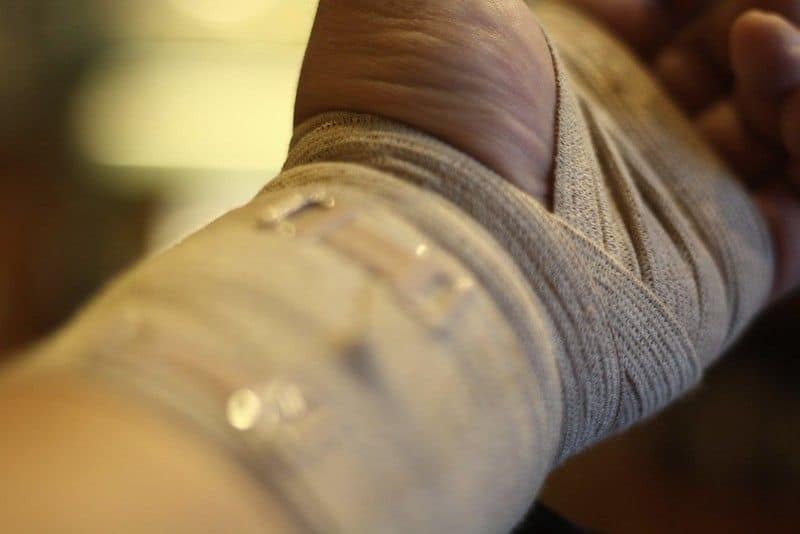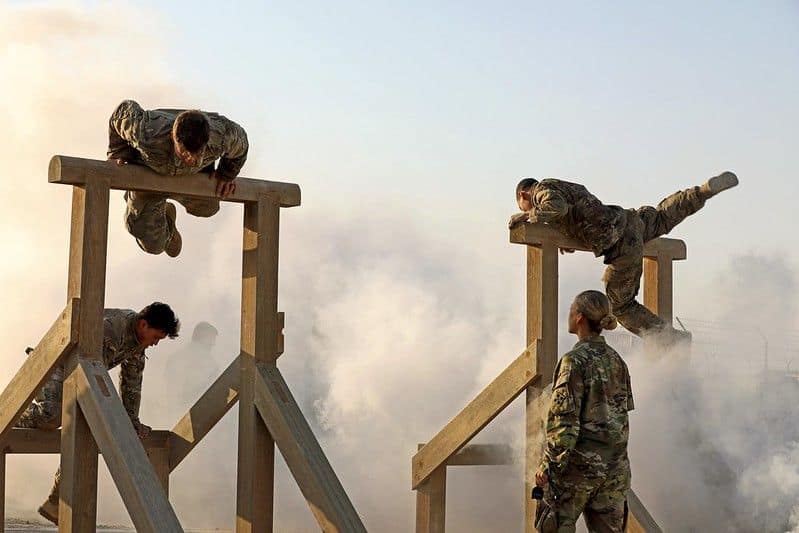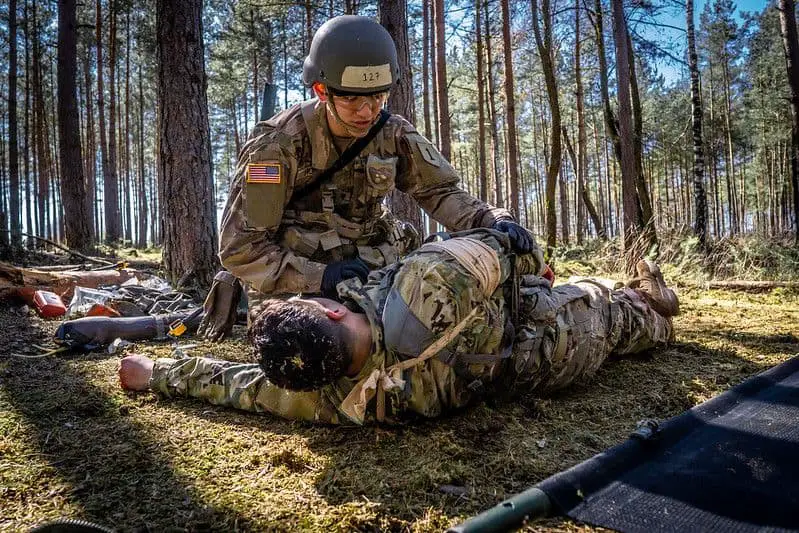
Rucking is a particularly gruelling aspect of military training. Unsurprisingly, it is associated with a wide spectrum of common injuries ranging from minor blistering to degenerative musculoskeletal deformations.
In this post, we’ll look into some of the common rucking injuries, what causes them, and how to avoid them.
Below are some of the injuries that may be caused by heavy load marching:
| 1 | Minor Foot Injuries |
| 2 | Nerve Compression Foot Injuries |
| 3 | Stress Fractures of the Foot |
| 4 | Lower Leg and Ankle Injuries |
What Are The Most Common Injuries?
1- Minor Foot Injuries
Blisters are the single most common injury among rucking soldiers. While quick to heal, blisters on the feet can be extremely painful and, if not cared for correctly, may become infected. These minor wounds are caused by persistent friction against the skin and most commonly appear on toes and heels.
As foot blisters account for as much as 50% of all military injuries, they should not be overlooked. They have the potential to make rucking very difficult and uncomfortable but proper foot hygiene is a good form of prevention. Here’s a full guide on how to avoid ruck march blisters.
2- Nerve Compression Foot Injuries
Various compression injuries have been linked to military rucking. They include digital paresthetica and metatarsalgia (source), the last of which is a condition that causes inflammation in foot soles. Pain is felt in the middle or front of the sole particularly when feet make contact with the ground.
The pain is usually described as a deep ache or a burning sensation but some soldiers experience shooting pains and numbness in their toes as well. Rucking may cause metatarsalgia (source) because it involves repetitive striking of the balls of the feet while they are carrying extra weight.
3- Stress Fractures of the Foot
There is evidence linking stress fractures in the feet to rigorous military rucking. While the progression of such injuries is unclear – fractures can normally be attributed to multiple activities – weighted marching probably weakens bones in the feet. When combined with running exercises and other forms of military training, it’s not uncommon to see the progressive decline and fracture bones like the metatarsal.
Degenerative injuries of this nature can be difficult to treat so prevention is strongly recommended.
4- Lower Leg and Ankle Injuries
Knee and ankle injuries account for between 25% and 50% of injuries sustained while rucking. This prevalence of lower limb injuries is due to increased pressure from heavy loads. Joints in the knees and ankles must sustain repetitive shocks (from the weight of the feet hitting the ground) and bear the strain of weighted loads. (source)
Some of these injuries are caused by falls during military ruck marches. More often, they are progressive injuries that develop over time as a result of undiagnosed or untreated sprains or tears.
What are the Causes of Rucking Injuries?
1- Individual Physical Factors
Weighted marching affects soldiers’ bodies in different ways because each solider has a unique posture and biochemistry. Risk of injury is significantly affected by individual musculoskeletal structures. Female soldiers – who generally have smaller frames – are at greater risk because their skeletons bear a greater strain from load carriage (source).
The same is true of smaller, leaner men with less muscle mass and soldiers who unconsciously overextend their necks.
2- Training Intensity

The type of ruck marching performed has a big impact on injury risk. There is a clear correlation between the intensity of ruck marches (measured by weight carried, distance travelled, frequency of marching and/or terrains traversed) and the likelihood of injury (source). It’s why rucking is a progressive exercise that becomes more intense as soldiers advance in their military training.
Load weight is the biggest risk factor when rucking. Studies suggest carrying loads equal to 10% of body weight (approximately 20lbs) is enough to significantly increase the risk of musculoskeletal injuries (source). Soldiers in the army routinely ruck with 80 to 50lbs. Subsequent declines in performance are acknowledged but, in a combat scenario, transporting such weight may be a realistic prospect.
Learn more about what soldiers carry in their backpacks.
Research has determined four rucks per month to be the optimal frequency for soldiers’ efficiency and improvement. Additional marches are likely to negatively affect performance and increase the risk of foot, ankle and lower leg injuries.
3- Low Quality Rucking Gear
The equipment used for rucking can greatly affect a soldier’s risk levels and their degree of physical discomfort. Military personnel are issued with properly fitted boots, a weight distributing army rucksack (featuring adjustable shoulder straps, waist belt, lightweight external frame, etc) and compact hydration bladders.
The provision of a high quality pack is essential as safe load carriage depends on even distributions of weight. Adjustable chest, shoulder and waist straps are used to transfer ruck weights off the lower back and onto other areas of muscle mass. This helps to reduce the likelihood of serious back strains.
The Military recommends the Modular Lightweight Load-Carrying Equipment (MOLLE) Rucksack. This is because it has an adjustable sternum, shoulder straps, waist/hip straps, and armor for better load distribution to different parts of the body. Check it out on Amazon (Link to Amazon) , alternatively, check out the best rucksacks for rucking for both army and everyday users.
Check out our complete recommended list of Rucking Gear.
How Can You Avoid Rucking Injuries?

1- Precondition
One of the best ways to lower the risk of all injuries is to condition the body for intensive training. This is built into army rucking programs to an extent – rucking schedules tend to increase in difficulty as soldiers develop – but recruits are strongly encouraged to pursue personal fitness programs as well.
The recommended way to start improving ruck march abilities is with a ‘light’ weight (10% – 15% of body weight). The soldier can then progress by increasing the distance travelled and load carried by a further 10% on each new ruck. It can take as long as six months to go from ‘beginner’ specs to the maximum weights required of serving military members without unreasonably increasing injury risk.
2- Keep Your Feet Dry and Reduce Friction
The recommended way to reduce friction and prevent foot blisters while marching is the doubling up of socks or wearing socks made from merino wool. Soldiers are advised to wear nylon or polypropylene socks or liners closest to their feet (inside layer) and well-fitting synthetic socks as an outer layer. This increases moisture wicking and stops the bare foot from rubbing against socks and boots.
It is imperative soldiers change their socks when saturated with perspiration or water and attend to any blisters (with band aids, antibiotic ointments, etc) promptly. The better an individual’s foot hygiene, the lower their risk of foot injuries.
3- Improve Your Fitness
Where possible, soldiers should engage in regular physical activity including aerobic, endurance and muscle strength exercises. Training programs designed to develop balance and agility can also have a positive impact on injury risk by helping to further strengthen the muscle tissues and increase flexibility in the joints.
Individuals who smoke have a higher risk of sustaining injuries while out rucking because nicotine increases the likelihood of overuse injuries (bursitis, tendonitis, etc) by 1.5 times. Quitting is strongly recommended for anybody thinking of joining the military.
4- Use Your Rucking Gear the Right Way
Proper use of assigned equipment is essential for the maintenance of health and fitness. Rucksacks, in particular, can exacerbate the risk of back injuries if not carried or handled carefully. They must be worn securely towards the middle of the back rather than left loose and resting on the base of the back where the muscle is smaller and narrower.
Any numbness, stinging, rubbing or pain should be addressed promptly by readjusting the rucksack’s position. Place any commonly used supplies in front pockets so there is only a minimal need to stretch or twist the torso. The soldier should remain in an upright walking posture as often as possible and limit the number of times they take off the pack.
5. Use A Weighted Vest
This may sound odd since some people may not consider walking with a weighted vest a real ruck session, it can elevate some pain. Everyones pain is different are different people are more susceptible to different injuries, but rucking with a weighted vest can be effective.
Rucking with a weighted vest puts less pressure on your shoulders and back. This is because the weight is more centered to your torso. It also forces the activation of your core, meaning it will strengthen your core and make you less reliant on pushing the weight with your back (and use your entire body to push the weight).
